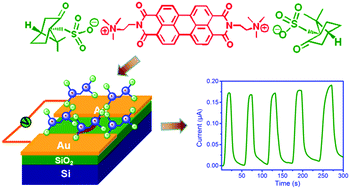Highly responsive ethylenediamine vapor sensor based on a perylenediimide–camphorsulfonic acid complex via ionic self-assembly†
Abstract
Two conductometric sensing devices (PR and PS) have been developed based on the perylene diimide skeleton with the oppositely charged chiral camphorsulfonic acid by ionic self-assembly. Both the PR and PS sensing devices exhibited high sensitivity, short response/recovery time, and excellent selectivity towards ethylenediamine vapor with a detection limit as low as 1.07 and 0.86 ppm, respectively. Experimental evidence demonstrated that strong hydrogen-bonding interactions between camphorsulfonic acid and ethylenediamine led to better performance of chiral PR and PS compared with their achiral counterparts. X-ray diffraction patterns combined with state-of-the-art computational calculations exhibit that strong π–π interaction and effective π–π overlap between adjacent PS dimers play an important role in increasing the electrical current and thus stabilizing the PS device, yet, the π–π stacking interactions in the PR device are negligible, in turn, leading to its poorer sensing performance than PS. The results suggest that camphorsulfonic acid can subtly tune the sensing performance of perylene devices via steric effects. The excellent sensing parameters, including selectivity, sensitivity, recyclability and detection limit, make chiral PR and PS feasible in highly efficient detection of ethylenediamine vapor.



 Please wait while we load your content...
Please wait while we load your content...